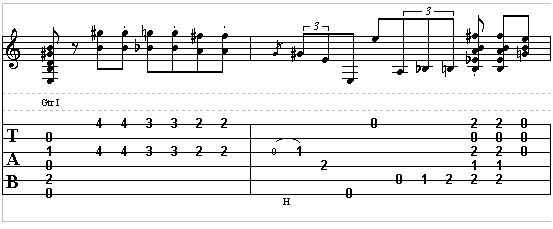In this lesson, we’ll apply common techniques to the basic turnaround structures we have learned so far. Simple things such as adding slides can really make the turnaround sound different. We’ll also learn a little more about the science involved when we play shifting melodies in a blues turnaround.
Adding Double Stops
A double stop is a fancy term used to describe the act of playing two notes simultaneously. Imagine it as playing a harmony along with a melody.
We can change the feel of the basic turnaround by playing the descending phrase with double stops in a shuffle rhythm.
Adding Slides
You can play the double stops on the beats shown in italics as staccato notes or you can
let them all ring out. Double stops are ideally played fingerstyle but you can play them with a pick and your middle or ring fingers. Try adding a bit of punch by sliding into the first double stop from the 2nd fret.
The next turnaround is an example in 12/8 time of keeping an I chord root note stationary and moving the other note down from the b7 to the 5 of the I chord. Here, the interval between the two notes is expanded with each step. Notice the double stop to establish the I chord
in bar 12 (if you find this difficult, just play the 2 on the A string).
Try the above using double stops instead of triplets.
In order to understand what’s happening in these shifting phrases so you can construct your own phrases, let’s look at the notes of the I7 chord and the intervals between them:
The intervals between the 3 and 5 and the 5 and b7 of the chord are both a minor 3rd (3 semi-tones or 3 frets on the guitar). Since our phrases start on beat 2 of bar 11 and end on beat 1 of bar 12 (3 steps over 4 beats), we can step up or down one fret at a time between these notes.
The interval between the root and 3, however, is a major third (4 semitones or 4 frets on the guitar). If we are moving between these notes (usually from the 3 to the root), one of our three steps obviously needs to be over two frets. The best place to do this is from the 2 to the root, so we would step down in the sequence; 3, b3, 2, root. If you use the root as one of your starting notes, it’s normally best to keep it static (but not always – see turnaround 4) and moves the other note between one of the other intervals (eg. 3 to 5, or b7 to 5 etc).
So, our best choices for moving between notes are,
3 to 1
3 to 5, 5 to 3
5 to b7, b7 to 5
The two notes you choose can be played in any order of high and low notes on any combination of strings depending on where they are on the fretboard and in what direction you want them to move. You’ll need to find notes that start and end in locations that can be reached by your fingers. Contrary motion phrases will generally need to cross over each other so that the intervals between the starting and ending notes doesn’t become too excessive.
To sum up, the basic guidelines for using a shifting phrase over the I chord played throughout bar 11 are,
- Pick two different notes from the I chord as starting notes
- Notes can descend or ascend together, expand or contract against a static root note, or move in contrary motion to each other
- Normally keep a root note static and move the other note against it
- The ending note or notes must be from the I chord
- Ending notes can be the same note
- If you find something that doesn’t fit any of the above but sounds good, it’s a new guideline


